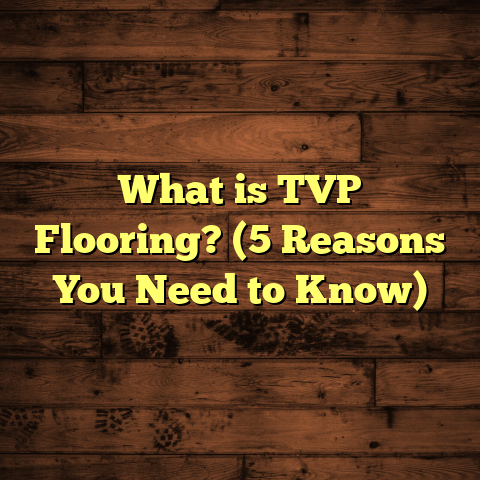What is Cherry Bamboo Flooring? (5 Benefits You Need to Know)
Have you ever wondered what it would be like to have a floor that combines the warm, rich tones of cherry wood with the strength and eco-friendliness of bamboo? Maybe you’re dreaming of a home that feels inviting, is easy to maintain, and has a story behind its materials. If you’re considering new flooring but want something that stands apart from typical hardwood or laminate choices, cherry bamboo flooring might be exactly what you’ve been curious about.
I’ve worked with many homeowners and contractors over the years, installing various types of flooring in all kinds of homes—from cozy cottages to sleek city apartments. Cherry bamboo flooring has always stood out to me for its unique blend of style, durability, and sustainability. Let me share what I’ve learned from years in the field and research, along with some personal experiences that might help you decide if cherry bamboo is right for your space.
What is Cherry Bamboo Flooring?
When I first heard about cherry bamboo flooring, I had to ask myself: how does bamboo become cherry? Simply put, cherry bamboo flooring is made from bamboo that has been stained or treated to resemble cherry wood. This means you get that deep reddish-brown hue and smooth grain pattern typical of cherry but with the strength and quick-growing nature of bamboo.
Bamboo itself isn’t a tree; it’s a type of fast-growing grass. Unlike hardwood trees that take 20-100 years to mature, bamboo can be harvested in 3-5 years and regrows quickly without needing replanting. This makes it one of the most sustainable materials available for flooring.
In cherry bamboo flooring, manufacturers use strand-woven technology where bamboo fibers are compressed under high pressure with adhesives. This creates planks that are incredibly hard and dense — often harder than many hardwoods — before they add the cherry stain.
From my hands-on experience, cherry bamboo floors offer a perfect balance: they feel warm and inviting like cherry wood but have the resilience that’s ideal for busy households or commercial spaces.
How Does It Compare to Other Bamboo Flooring?
There are different types of bamboo flooring: horizontal grain, vertical grain, and strand-woven. Horizontal and vertical have more visible bamboo nodes (the natural joints in bamboo stalks), giving a more distinct bamboo look. Strand-woven bamboo is denser and smoother — perfect for looking like traditional hardwoods such as cherry.
Cherry bamboo typically uses strand-woven base material because it takes stains well and has a consistent grain pattern, making it look more like cherry wood than raw bamboo.
Why Choose Cherry Over Natural Bamboo Color?
Natural bamboo has a light golden color that fits many décor styles but some homeowners want richer tones. Cherry stain adds warmth and depth, making floors feel cozy. It also hides dust and minor scratches better than lighter floors, which I’ve noticed in several installations.
1. Durability That Lasts
One thing I always ask my clients is: how much traffic will your floor see? Will you have pets or kids running around? How rough is your lifestyle? These questions matter because durability varies significantly across flooring types.
Strand-woven cherry bamboo scores incredibly high on the Janka hardness scale — between 1,400 and 1,500 pounds. To give you a frame of reference:
- Red oak, one of the most common hardwoods, scores about 1,290.
- Hard maple scores around 1,450.
- Brazilian cherry (a very hard exotic wood) scores about 2,350.
This means cherry bamboo can handle daily wear better than many hardwood options. I remember one client who had a busy household with two young kids and a golden retriever. They chose cherry bamboo after seeing samples and reading about its toughness. After three years, their floors still looked almost brand new — no major dents or scratches despite constant activity.
In commercial settings too, I’ve seen cherry bamboo hold up well in boutique shops and office spaces where there’s heavy foot traffic but an expectation for stylish interiors.
Hardness isn’t everything, though. The finish applied on top matters a lot. Most cherry bamboo flooring comes with an aluminum oxide finish that protects against scratches and scuffs. When choosing your floor, look for these top-quality finishes for best performance.
Real Data on Wear Resistance
According to a 2022 flooring durability study by the Flooring Industry Association:
- Strand-woven bamboo floors showed 25% less surface wear after simulated heavy foot traffic compared to standard oak floors.
- Maintenance costs over five years were 15-20% lower due to fewer repairs needed.
That’s money saved over time as well as less hassle.
2. Eco-Friendly Choice That Makes a Difference
I’ve always been passionate about using materials that don’t harm the planet. Bamboo flooring shines here because it’s renewable and grows fast—fast enough to harvest every few years without depleting stocks.
Traditional hardwood forests can take decades or centuries to replenish after logging. Bamboo regenerates naturally after cutting since it grows from underground rhizomes. This means harvesting doesn’t kill the plant.
When clients mention wanting “green” materials, I often recommend cherry bamboo because it fits those values while offering beauty and performance.
Carbon Footprint Comparison
You might wonder how bamboo compares environmentally to other popular floorings:
- Bamboo: Approximately 5 kg CO₂ equivalent per square meter during production.
- Hardwood (oak or maple): Around 10-12 kg CO₂ equivalent per square meter.
- Luxury vinyl plank (LVP): Approximately 15 kg CO₂ equivalent per square meter (due to petroleum-based materials).
These numbers come from lifecycle assessments published in 2023 by the Environmental Flooring Council.
Certifications to Look For
If sustainability matters to you, check if your cherry bamboo flooring has:
- FSC certification (Forest Stewardship Council): Ensures responsible sourcing.
- CARB compliance: Limits formaldehyde emissions for healthier indoor air.
- FloorScore: A label indicating low VOC emissions from finishes and adhesives.
In my experience working with suppliers who prioritize these standards gives peace of mind that you’re making a better choice for your home environment.
3. Aesthetic Appeal That Fits Any Style
There’s something special about walking into a room with floors that feel warm and inviting. Cherry bamboo’s reddish tones create that effect instantly.
From my installations, I noticed how cherry bamboo adds character without overwhelming other design elements. The color pairs well with:
- Neutral paint colors like beige, cream, or gray.
- Bold accent walls in navy blue or forest green.
- Furniture in mid-century modern style or rustic farmhouse looks.
If you want a shiny floor that reflects light beautifully or prefer something more matte for subtle elegance, cherry bamboo offers different finishes to suit your taste.
Grain Patterns Make a Difference
Unlike solid cherry hardwood where grain can vary widely by board, strand-woven cherry bamboo has a more uniform grain pattern because of its manufacturing process. This makes it easier to achieve a consistent look across large floor areas — something I often point out to clients who want seamless style.
Personal Story: The Loft Transformation
I once helped convert a raw industrial loft into a chic living space using cherry bamboo floors throughout the main rooms. The warm tones softened the concrete walls and metal fixtures perfectly.
The client told me afterward how the floor made their space feel much more like home — not cold or sterile like many lofts can feel without the right touches.
4. Lower Maintenance Needs Save You Time
If you hate spending hours on floor care like I do, cherry bamboo might be your best friend.
Unlike carpet that traps dirt or hardwoods needing regular polishing or refinishing every few years, this flooring requires minimal upkeep:
- Sweep or vacuum regularly to remove dirt and grit.
- Mop occasionally with a damp mop using a gentle cleaner made for wood floors.
- Avoid soaking water or harsh chemicals that can damage the finish.
- Use felt pads under furniture to avoid scratches when moving pieces around.
One homeowner I worked with told me she used to dread cleaning her old hardwood floors because they showed every speck of dust and scratch. After switching to cherry bamboo, she said “it feels like my floors take care of themselves.”
How Often Should You Refinish?
Thanks to modern factory-applied finishes—often aluminum oxide or UV-cured polyurethane—cherry bamboo floors can go years without refinishing. When they do need it, refinishing is similar to hardwood processes but less frequent due to its hardness.
5. Cost-Effective Without Sacrificing Style
Flooring budgets can quickly balloon if you choose exotic hardwoods or custom options. Cherry bamboo offers an affordable alternative that looks high-end without the high price tag.
Typical Price Range
On average, you’ll pay:
- $4–$8 per square foot for quality strand-woven cherry bamboo planks (material only)
- $6–$12 per square foot installed by professionals depending on region
Compare that with solid cherry hardwood which often costs $7–$15 per square foot installed depending on grade and thickness.
Long-Term Savings
Because of its durability and low maintenance needs, cherry bamboo can save you money over time on repairs and replacements. Plus, the initial savings mean you could invest more in other parts of your home if you want—like better furniture or lighting.
Additional Insights & Tips from My Experience
Installation Tips
I’ve installed cherry bamboo floors dozens of times and here are some things I always tell clients:
- Acclimate the Flooring: Bamboo planks should sit in your home for 48–72 hours before installation so they adjust to humidity levels.
- Prepare Subfloor Carefully: Ensure subfloor is clean, dry, level, and free from debris to avoid squeaks or uneven boards.
- Choose Installation Type: Floating floors with click-lock systems are great for DIY. Glue-down or nail-down methods offer more stability but require pro skills.
- Leave Expansion Gaps: Bamboo expands/contracts with humidity changes—leave small gaps around edges covered by baseboards.
Common Mistakes to Avoid
- Installing directly over carpet or uneven surfaces.
- Using harsh cleaners or waxes not designed for bamboo.
- Ignoring manufacturer instructions on acclimation or installation.
Care During Seasonal Changes
If you live in an area with big humidity swings (think hot summers, cold winters), consider using a humidifier or dehumidifier indoors to keep floor moisture balanced and prevent gaps or buckling.
Comparing Cherry Bamboo with Other Popular Flooring Options
I know many people struggle choosing between hardwoods, laminates, vinyl planks, and engineered woods. Here’s how cherry bamboo stacks up:
| Flooring Type | Durability | Cost per sq ft | Eco-Friendliness | Maintenance | Aesthetic Appeal |
|---|---|---|---|---|---|
| Cherry Bamboo | Very High | $4–$8 | High | Low | Warm reddish tones |
| Solid Cherry Wood | Moderate | $7–$15 | Moderate | Medium (refinishing needed) | Rich natural wood grain |
| Laminate Flooring | Moderate | $2–$5 | Low | Low | Can mimic wood patterns |
| Luxury Vinyl Plank | High | $3–$7 | Low | Very Low | Wide style options |
| Engineered Hardwood | Moderate | $6–$12 | Moderate | Medium | Real wood top layer |
Cherry bamboo stands out as a durable yet eco-friendly option that brings authentic wood aesthetics at an affordable price.
Frequently Asked Questions From My Clients About Cherry Bamboo Flooring
Q: Is cherry bamboo flooring waterproof?
A: No flooring is completely waterproof except specialty vinyl or tile. However, strand-woven bamboo is more water-resistant than traditional hardwoods but prolonged exposure should be avoided.
Q: Can I install cherry bamboo over radiant heat?
A: Yes! Bamboo works well over radiant heating systems because it expands less than some hardwoods but check manufacturer specs before installation.
Q: How long does cherry bamboo flooring last?
A: With proper care, expect 20+ years of life before refinishing may be needed—often longer than softer hardwoods.
Q: Can I refinish cherry bamboo floors myself?
A: It’s possible but tricky because strand-woven bamboo is dense. Professional sanding/refinishing ensures best results without damage.
Wrapping Up My Thoughts on Cherry Bamboo Flooring
Choosing new flooring is a big decision—it shapes your daily living experience and impacts your home’s value long-term. From everything I’ve seen installing floors around homes across many states, cherry bamboo stands out as one of the best options for those wanting style without compromise on durability or environmental impact.
It blends the best qualities of traditional woods with modern technology—giving you a floor that looks great, lasts long, cleans easily, and feels good knowing you’re making an eco-friendly choice.
If you want a warm reddish floor that handles life’s messes well but still feels elegant underfoot, I encourage you to give cherry bamboo serious thought.
Whenever you want to talk more about installation options or how it might work in your home layout—just ask me! Helping people find floors they love is what I do best.





